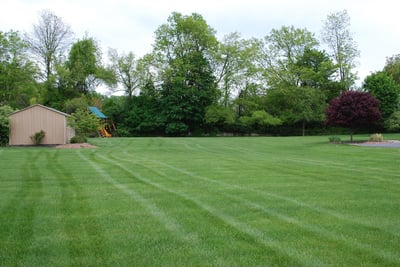 Most people don’t realize just how much impact mowing has on a lawn’s appearance. Of course, you know that keeping your lawn at a reasonable height helps it look neat and tidy, but what you probably don’t realize is that mowing can also have an impact on color, thickness, and overall health and performance of your turfgrass. It’s a simple task that can have huge ramifications (either good or bad).
Most people don’t realize just how much impact mowing has on a lawn’s appearance. Of course, you know that keeping your lawn at a reasonable height helps it look neat and tidy, but what you probably don’t realize is that mowing can also have an impact on color, thickness, and overall health and performance of your turfgrass. It’s a simple task that can have huge ramifications (either good or bad).
Although we offer a range of lawn care services (like aeration and overseeding, fertilization, and weed control), we do not offer mowing. Even so, we think it’s incredibly important that lawns are mowed properly for the reasons mentioned above.
After all, we’d like to see that all of our customers have the best possible results and mowing plays a big role in that. As a result, we’ve rounded up some of our very best mowing tips to get you on the right track.
General Mowing Recommendations
More often than not, most people tend to mow their lawns too short. The ideal mowing height for lawns is 3.5 inches.
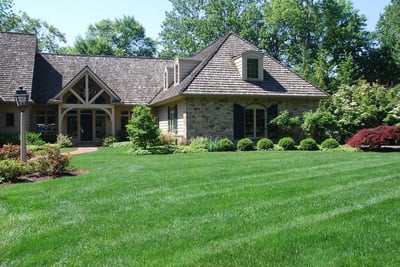 Though it’s obviously more work, it’s ideal to mow more often (as many as one to two times per week). You should mow to remove only one-third of a blade at a time so that you aren’t having so many clippings accumulate on top of the lawn. This will also help the lawn appear greener because grass is greenest where it gets the most sunlight. If you mow your grass too short, you’ll cut off the greenest parts of it and it could appear yellowish until it regains color again in the following week.
Though it’s obviously more work, it’s ideal to mow more often (as many as one to two times per week). You should mow to remove only one-third of a blade at a time so that you aren’t having so many clippings accumulate on top of the lawn. This will also help the lawn appear greener because grass is greenest where it gets the most sunlight. If you mow your grass too short, you’ll cut off the greenest parts of it and it could appear yellowish until it regains color again in the following week.
Another important general recommendation is to ensure you’re using a sharp mower blade and a level mower deck (or evenly inflated tires). If possible, use a mulching blade so that you can return your grass clippings to the lawn as natural compost.
Mowing the Lawn When Wet
Mowing a lawn after rain, when it’s very wet, can leave cut grass in clumps. Unfortunately, this can lead to discoloration or even dead spots if in excess. Mowing a lawn in rain can also be problematic since it can create tire ruts which will lead to bumps in your lawn. In general, you should avoid mowing the lawn when it’s really wet.
Mowing the Lawn After Fertilizing
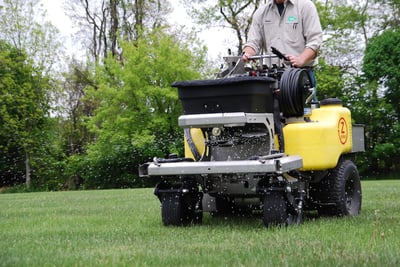 Though a lot of people worry about mowing interfering with fertilization, the truth is that the mower isn’t going to pick up granules and have any significant impact. Granular materials will fall down to the soil below where it will stay put and not be “sucked up” (a myth that is commonly held) or jostled in any way that’s going to impact results.
Though a lot of people worry about mowing interfering with fertilization, the truth is that the mower isn’t going to pick up granules and have any significant impact. Granular materials will fall down to the soil below where it will stay put and not be “sucked up” (a myth that is commonly held) or jostled in any way that’s going to impact results.
Mowing the Lawn After Spraying for Weeds
When it comes to spraying for weeds, you want to be sure that liquid weed control materials get fully absorbed by the leaves. That means that you should wait until the product dries to mow—ideally at least 24 hours.
Mowing and Weed Growth
Mowing the lawn too short can leave it prone to weed growth. That’s because opportunistic weeds are more likely to invade where they have easy access to sunlight and don’t have to compete with a lot of healthy turf. To prevent this, aim for that 3.5-inch height we mentioned earlier.
In addition, be careful of edges. Scalping your edges (such as around the driveway or walkways) with a string trimmer can make those thinned out areas prone to weeds as well.
Mowing and Drought Stress
When your lawn is experiencing drought stress, then you absolutely need to cut back on how often you’re mowing. People often don’t realize that the act of mowing itself puts stress on a lawn, after all, you’re making cuts.
If it’s already stressed from lack of water, cutting it is going to negatively impact its health even more. Instead, lessen your mowing intervals and maintain grass at a higher height while it’s recovering.
Mowing and the Spread of Turf Disease
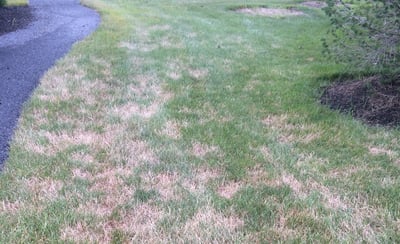 Most people don’t realize how easily disease can be spread via the lawn mower. That means that if you have a turf disease in one area of your lawn, and you mow it, you might spread it all over.
Most people don’t realize how easily disease can be spread via the lawn mower. That means that if you have a turf disease in one area of your lawn, and you mow it, you might spread it all over.
It also means that if you have a commercial mowing company cutting your grass and they mow a diseased lawn and then come to your property, they can spread it around on your lawn. To avoid this, the mower and its blades and deck should ideally be washed after each mowing.
If your lawn has a turf disease, you’ll also want to make sure that you’re bagging the clippings so that you aren’t contributing to further spreading the disease.
Mowing the Lawn After Seeding
If you’ve recently had an aeration and overseeding service performed you might be worried that mowing will disrupt those efforts. The truth is, with aeration, seeds fall into the holes that were created and stay there. Mowing is not going to have a negative impact. You may just have muddy shoes and mower for the next few times you mow.
Mowing the Lawn After Frost
A lot of homeowners remain unsure how late into the season they should mow. In our region, mowing often goes as late as November. There are still warm days in there that will keep grass actively growing. Of course, there may also be some frost to contend with. The best practice is to wait for the frost to melt. Mowing at freezing temperatures can damage the grass.
Just don’t stop mowing for the season too early as leaving your grass long as you head into winter months can make it more prone to snow mold. For your last mow of the season, you should plan to go a little shorter, somewhere around 2.5-3 inches. Just be careful not to scalp the lawn.
Partnering with Homeowners for the Best Results
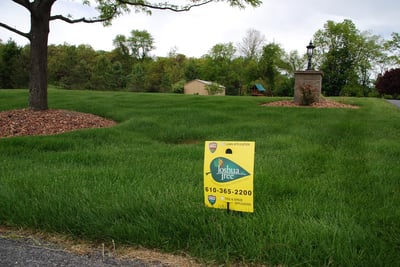 At Joshua Tree, we truly want to see that all of our lawn care customers have the best possible results. But there are some factors that are out of our control—mowing being one of them.
At Joshua Tree, we truly want to see that all of our lawn care customers have the best possible results. But there are some factors that are out of our control—mowing being one of them.
Most people don’t realize that the way in which their lawn is mowed really can contribute to either the success—or failure—of their overall lawn health. Following these recommendations and making changes where needed can have a big impact. Of course, that may mean that if you notice your commercial lawn care company isn’t following proper mowing protocol, that you’ll need to have a conversation with them about changes.
In the end, we believe that partnering with homeowners allows us to achieve the best possible results—together.
With the right care for your lawn, you’ll gain valuable peace of mind. If you’re interested in having your lawn inspected and its health assured, contact us for a free quote or give us a call at 833-JTE-TREE.



